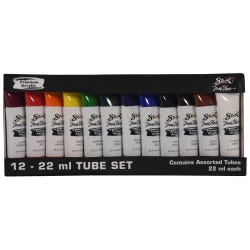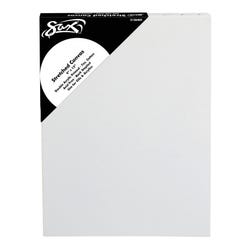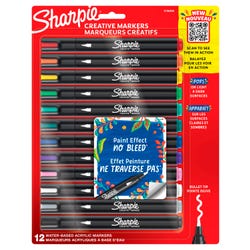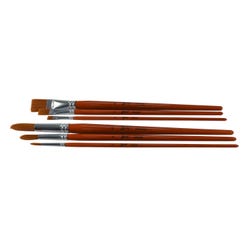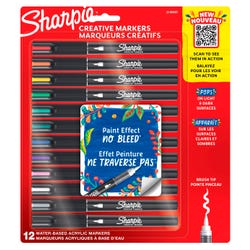“Creative” Versatile Abstract

Description
Lesson Plan and Artwork by Joe Culotta
This lesson demonstrates that when creating an artwork, it isn’t necessary to use just one medium. Changing mediums allows the artist to explore possibilities and add variety. New Sharpie® Creative Markers work very well over the rich body and color of the Sax® Acrylic Paint on canvas. The high quality of the Sharpie Creative Markers and the richly colored Sax Acrylics will excite students to experiment, discover, and create wonderful paintings while honing their artistic abilities.
Objectives
- Research the term “mixed media” and the abstract art process.
- Explore the use of Sharpie Creative Markers as a tool to accent and use on a mixed media work.
- Utilize the Elements and Principles of Design while combining two mediums to create an abstract work of art.
Supplies Needed
Sharpie® Creative Markers, Brush Tip, Pack of 12
Sharpie® Creative Markers, Bullet Tip, Pack of 12
Sax® Premium Heavy-Bodied Acrylic, 0.75 oz Tubes, Set of 12
Sax® Copper Acrylic Paint Brushes, Set of 6
Sax® Quality Stretched Canvas, White, 9" x 12"
*Here are the supplies needed for this lesson plan for reference. Find a convenient carousel of shoppable products for this lesson below.
Standards
Standard #1: Generate and conceptualize artistic ideas and work.
Standard #7: Perceive and analyze artistic work.
Standard #8: Interpret intent and meaning in artistic work.
Instructions
1
Inform students that they will create an abstract painting done on canvas with both Sharpie Creative Markers and Sax Acrylic Paint as their mediums. Sax Acrylics are rich in color and consistency. Sharpie Creative Markers are offered in brush and regular tip sizes. These water-based markers can be used on wood, paper, rocks, metal, plastic, ceramics, canvas, and glass. They are opaque and quite striking, and show especially well over dark colors.
2
Show and discuss various abstract art movements. You can find examples in books, the internet, and museum tours.
3
Have students research to identify the characteristics of each art movement under the umbrella of “abstract” art and then pick one to emulate in their own work. Research the art movements such as Cubism, Color Fieldwork, Fauvism, and Abstract Expressionism.
4
After researching, the students will create thumbnail sketches for the work, expressing the theme and style they will use.
5
On sheets of canvas, students will experiment with Sharpie Creative Markers and Sax Acrylic to develop color schemes and practice painting techniques such as impasto, overlays, and mixed media applications. IMPORTANT: Note, the acrylic base must be dry before you overlay the Sharpie Creative Markers.
6
As you guide students through the progression of steps to completion, it is good to remind them of the Elements and Principles of Design and how to construct a balanced color scheme and good composition for their painting.
7
The students are now ready to begin their painting. Block in lights and darks with neutral tones on the canvas (do not draw on canvas in pencil, or the graphite will bleed through the paint).
8
Keep layering until the intended composition begins to take form. Have students think of it as building layers, and the layers as the building blocks of the painting. The lights and darks create the contrast.
9
Finalize the acrylic painted portion of the work and allow to dry overnight.
10
Use Sharpie Creative Markers to define specific areas of interest and pull in the Elements and Principles. Use the various tips to add movement, texture and/or pattern. Create intricate linework to bring unity or balance. Use the striking colors to emphasize contrast.
11
Upon completion, students will discuss the final art piece and explain the style they chose to represent. Take time for students to evaluate their own work and the work of others.



